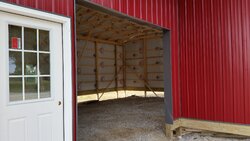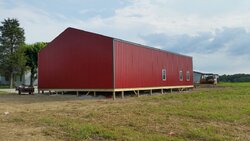Under slab insulation
- Thread starter Buzz Saw
- Start date
-
Active since 1995, Hearth.com is THE place on the internet for free information and advice about wood stoves, pellet stoves and other energy saving equipment.
We strive to provide opinions, articles, discussions and history related to Hearth Products and in a more general sense, energy issues.
We promote the EFFICIENT, RESPONSIBLE, CLEAN and SAFE use of all fuels, whether renewable or fossil.
You are using an out of date browser. It may not display this or other websites correctly.
You should upgrade or use an alternative browser.
You should upgrade or use an alternative browser.
- Status
- Not open for further replies.
Isaac Carlson
Minister of Fire
If you are going to use foam, use it. Run it all the way down and bury a foot in the ground. That will help with frost.
When we did our house, the foam board was placed on the level gravel, then concrete poured over the foam. It's really no difference for insulation IMHO as all you are doing is isolating the ground temperature from your building temps. As Isaac says, bury the foam at the walls, otherwise you'll get frost creeping in the edges. I assume you are fully insulating the building? If not, no need for any foam.
You might want to consider running a plastic pipe loop through the concrete and have solar collectors on the roof heating the circuit in the floor. I would sure use all that roof space for solar of one kind or another.
You might want to consider running a plastic pipe loop through the concrete and have solar collectors on the roof heating the circuit in the floor. I would sure use all that roof space for solar of one kind or another.
ironpony
Minister of Fire
when I did mine the foam sat on the footing 3 feet deep, not sure on a pole type structure. I would agree with above of at least a foot deep
just reread your post, I would go down the full 30" depth. also nothing under slab unless you are doing radiant floor heat.
just reread your post, I would go down the full 30" depth. also nothing under slab unless you are doing radiant floor heat.
Highbeam
Minister of Fire
I have a pole barn like yours and I insulated with foam and installed the radiant heat tubes. No heat in the tubes yet. I also insulated the walls and ceiling.
It drives me crazy to see a building built like yours where they failed to place and compact the fill before building a building. Now you need to go in there and try to do it without damaging the building and you can't possibly compact the edges of the slab. Oh well, let's look ahead.
The folks that know about these things say that most heat is lost from the edge of the slab. The ground under the slab is always 50 degrees after all. They say to run the foam vertical from top of slab to the frost line. Place all your fill, inside and outside of the building, place all your gravel to grade, then 6 mil poly, and then 2" foam either under the whole slab (what I did) or for the first 5 to 10 feet around the perimeter. Then staple the tubes to the foam, and then steel mesh on top of tubes, then pour concrete.
I would insulate the slab like this regardless of whether or not you plan to use in floor heat. The tubes in the slab only add a small cost to the project so put them in to make the slab "radiant ready".
Oh and I'm a big fan of EPS (25psi) for under the slab but for vertical I used XPS since it just holds up better to abrasion during the backfill.
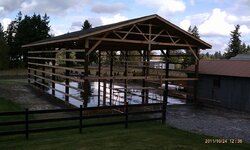
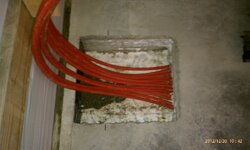
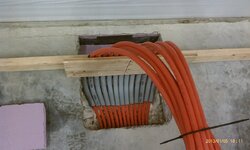
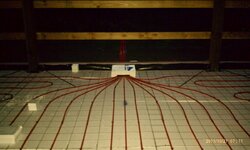
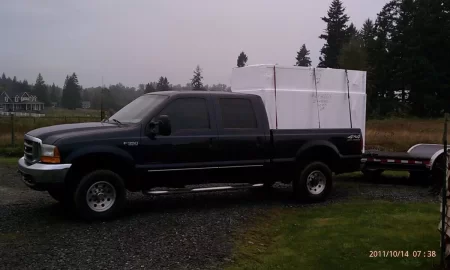
It drives me crazy to see a building built like yours where they failed to place and compact the fill before building a building. Now you need to go in there and try to do it without damaging the building and you can't possibly compact the edges of the slab. Oh well, let's look ahead.
The folks that know about these things say that most heat is lost from the edge of the slab. The ground under the slab is always 50 degrees after all. They say to run the foam vertical from top of slab to the frost line. Place all your fill, inside and outside of the building, place all your gravel to grade, then 6 mil poly, and then 2" foam either under the whole slab (what I did) or for the first 5 to 10 feet around the perimeter. Then staple the tubes to the foam, and then steel mesh on top of tubes, then pour concrete.
I would insulate the slab like this regardless of whether or not you plan to use in floor heat. The tubes in the slab only add a small cost to the project so put them in to make the slab "radiant ready".
Oh and I'm a big fan of EPS (25psi) for under the slab but for vertical I used XPS since it just holds up better to abrasion during the backfill.





Last edited by a moderator:
Yes, the whole building will be eventually be insulated.When we did our house, the foam board was placed on the level gravel, then concrete poured over the foam. It's really no difference for insulation IMHO as all you are doing is isolating the ground temperature from your building temps. As Isaac says, bury the foam at the walls, otherwise you'll get frost creeping in the edges. I assume you are fully insulating the building? If not, no need for any foam.
You might want to consider running a plastic pipe loop through the concrete and have solar collectors on the roof heating the circuit in the floor. I would sure use all that roof space for solar of one kind or another.
I have plans for solar after the building is completed. The dream is to have solar heating my thermal storage, ideally a Garn. Lots of work till I can set in a Garn or any boiler for that matter.
So 30" to my current ground level and call that good?when I did mine the foam sat on the footing 3 feet deep, not sure on a pole type structure. I would agree with above of at least a foot deep
just reread your post, I would go down the full 30" depth. also nothing under slab unless you are doing radiant floor heat.
After the outside is graged into place only about 4" of the top treated 2x8 will be visible.
If I can get dig some dirt out with my FEL I'll take out as much as I can.
Not building the pad up was my call. Reason being I live close to several quarries and I can get 304's trucked in for a comparable price(or cheaper) as dirt. As far as compacting a vibtrating double roller does a pretty good job on all but the outer 12" or so. The last 12" I can water down, hopefully to get enough settling.I have a pole barn like yours and I insulated with foam and installed the radiant heat tubes. No heat in the tubes yet. I also insulated the walls and ceiling.
It drives me crazy to see a building built like yours where they failed to place and compact the fill before building a building. Now you need to go in there and try to do it without damaging the building and you can't possibly compact the edges of the slab. Oh well, let's look ahead.
The folks that know about these things say that most heat is lost from the edge of the slab. The ground under the slab is always 50 degrees after all. They say to run the foam vertical from top of slab to the frost line. Place all your fill, inside and outside of the building, place all your gravel to grade, then 6 mil poly, and then 2" foam either under the whole slab (what I did) or for the first 5 to 10 feet around the perimeter. Then staple the tubes to the foam, and then steel mesh on top of tubes, then pour concrete.
I would insulate the slab like this regardless of whether or not you plan to use in floor heat. The tubes in the slab only add a small cost to the project so put them in to make the slab "radiant ready".
Oh and I'm a big fan of EPS (25psi) for under the slab but for vertical I used XPS since it just holds up better to abrasion during the backfill.
View attachment 161117 View attachment 161118 View attachment 161119 View attachment 161120 View attachment 161121
Knowing what I know now I would look closer at pouring a foundation and building a pole barn on top of the foundation. Also if redoing a pole barn I would have opened up a trench and out foam into a 4" wide trench right next to the poles... Oh well moving forward.
What are the differences in foam board? I take it not all foam board is created equal?
Highbeam
Minister of Fire
There is EPS and XPS foam board. Both are polystyrene, both are available in 25 psi compressive strength, and both are made for underslab installations. The EPS is expanded (bunch of little balls melted together) and the XPS is extruded (more like a cast liquid material). Cost for XPS is way way higher but the only benefit is better abrasion resistance during construction and I find the XPS easier to shape with a saw as it "chunks" less. Both are R-5 per inch. You don't need 25 psi, 15 psi is usually stronger than the ground under it, but 25 psi is better.
It is not too late to install vertical foam from top of slab to finished grade frost line. Do it. Your biggest challenge with using stone as backfill is making sure that surface water doesn't pool under your building. Grade the dirt to drain then fill with stone. Hopefully this 304 stone you speak of (stone names are a regional thing) is crushed rock with fines so it will lock in and compact.
Oh and you can still pour your slab with a thickened edge to act as a foundation for the interior walls. I framed out the pole barn bays and insulated. Shot nails through a treated sill plate into the top of slab.
It is not too late to install vertical foam from top of slab to finished grade frost line. Do it. Your biggest challenge with using stone as backfill is making sure that surface water doesn't pool under your building. Grade the dirt to drain then fill with stone. Hopefully this 304 stone you speak of (stone names are a regional thing) is crushed rock with fines so it will lock in and compact.
Oh and you can still pour your slab with a thickened edge to act as a foundation for the interior walls. I framed out the pole barn bays and insulated. Shot nails through a treated sill plate into the top of slab.
There is EPS and XPS foam board. Both are polystyrene, both are available in 25 psi compressive strength, and both are made for underslab installations. The EPS is expanded (bunch of little balls melted together) and the XPS is extruded (more like a cast liquid material). Cost for XPS is way way higher but the only benefit is better abrasion resistance during construction and I find the XPS easier to shape with a saw as it "chunks" less. Both are R-5 per inch. You don't need 25 psi, 15 psi is usually stronger than the ground under it, but 25 psi is better.
It is not too late to install vertical foam from top of slab to finished grade frost line. Do it. Your biggest challenge with using stone as backfill is making sure that surface water doesn't pool under your building. Grade the dirt to drain then fill with stone. Hopefully this 304 stone you speak of (stone names are a regional thing) is crushed rock with fines so it will lock in and compact.
Oh and you can still pour your slab with a thickened edge to act as a foundation for the interior walls. I framed out the pole barn bays and insulated. Shot nails through a treated sill plate into the top of slab.
So ESP is the type of foam used for packing material? XPS is the typical foam board I see in construction, typically blue or pink.
I'm not to concerned with water pool under the building because there is a 4" perforated tile that runs under the building. In theory that drain like a footer tile.
304 stone is crushed limestone with powder. The stone is about the size of a flattened golfball, and that is on the big end for size. This stuff locks in tight after being compacted.
After I get the mess cleaned up left by the builders (are all builders slobs or just Mennonite's?) I plan on digging out some more dirt. I'll get out as much as I can with my little tractor and I'll have to call it good enough unless I can borrow a mini excavator to really get some work done.
When you shot nails into the concrete weren't you concerned about hitting your pex lines?
The lines are under the slab, which should be 4"+. I hit one when I drilled to put in a lag bolt once. What are the odds?When you shot nails into the concrete weren't you concerned about hitting your pex lines?
How should I insulated were my garage doors will be? If I have concrete that comes out a foot in front of the door do I insulate on the edge of were the concrete will be or not insulate at all and just let the heat loss be what it is in that area?
I thought the lines were supposed to be closer to the surface. Will it heat differently at different depths?The lines are under the slab, which should be 4"+. I hit one when I drilled to put in a lag bolt once. What are the odds?
Was the PEX the repairable? If so how can you fix it? Fill the hole with hydraulic concrete?
It was pvc not pex that I used 3 decades ago. I put loops of pipe in the concrete in our south facing window wall with the intention that someday I might hook it up to solar collectors and pre-heat hot water. Someday has not arrived, been too busy.If so how can you fix it?


Soooo, hole was never fixed. The hook-ups got tiled over a few years ago so no one will ever know. The only reason I know I hit the pipe is that the drill bit came back up with bits of black plastic on it. Sh!t happens.
Highbeam
Minister of Fire
So ESP is the type of foam used for packing material? XPS is the typical foam board I see in construction, typically blue or pink.
I'm not to concerned with water pool under the building because there is a 4" perforated tile that runs under the building. In theory that drain like a footer tile.
304 stone is crushed limestone with powder. The stone is about the size of a flattened golfball, and that is on the big end for size. This stuff locks in tight after being compacted.
After I get the mess cleaned up left by the builders (are all builders slobs or just Mennonite's?) I plan on digging out some more dirt. I'll get out as much as I can with my little tractor and I'll have to call it good enough unless I can borrow a mini excavator to really get some work done.
When you shot nails into the concrete weren't you concerned about hitting your pex lines?
The pex is laid out with high precision. First loop and was 6" inside of the poles and the nails shot into boards between the poles. Also, as mentioned, the pex is on the bottom of 5" of concrete.
Highbeam
Minister of Fire
How should I insulated were my garage doors will be? If I have concrete that comes out a foot in front of the door do I insulate on the edge of were the concrete will be or not insulate at all and just let the heat loss be what it is in that area?
Good question. There will be heat loss where the heated slab runs under the door. This will prevent the door seal from freezing shut. Also, the cat loves setting there.
ironpony
Minister of Fire
Good question. There will be heat loss where the heated slab runs under the door. This will prevent the door seal from freezing shut. Also, the cat loves setting there.
I would cut a slot with a concrete saw and create a thermal break. 1/2 inch wide and foam fill it. or if you still havent poured it, form it to the inside of door, then foam or expansion board which lines up under door and pour apron up to that. even a piece of PT would create a thermal break.
Highbeam
Minister of Fire
I would cut a slot with a concrete saw and create a thermal break. 1/2 inch wide and foam fill it. or if you still havent poured it, form it to the inside of door, then foam or expansion board which lines up under door and pour apron up to that. even a piece of PT would create a thermal break.
Just remember how structurally important this spot is. Right in the wheelpath and there is usually some sort of ramp into the slab. People thicken this area for a reason.
Hoping to get a Garn, would that do the trick?Put in a big wood stove and a little cold seeping in won't matter.
- Status
- Not open for further replies.
Similar threads
- Replies
- 15
- Views
- 864
- Replies
- 12
- Views
- 423
- Replies
- 1
- Views
- 510
- Replies
- 6
- Views
- 1K


